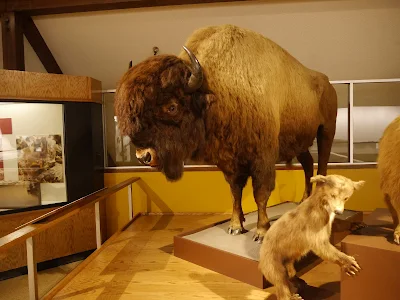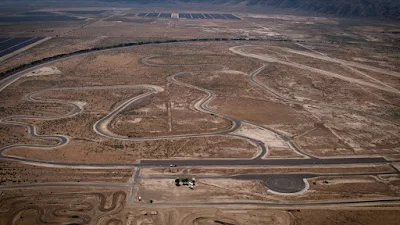.JPG) |
| John R Beyer at the county museum |
According to David Myers, Chief Deputy of the San Bernardino County Museum, nearly eighty thousand people wander the hallways, admiring the exhibits. Heads twisting this way and that way, gaining as much knowledge as they can during their visit.
“That’s a lot of people visiting a county museum,” I stated, while Laureen was sipping on her morning coffee.
“Shall we visit, then?”
“Oh, we shall,” I responded.
So, one sunny Saturday morning, we headed south on the I-15 for a day of exploring what the museum had in store for us.
“We might get hungry walking around the museum, since we didn’t eat breakfast,” Laureen said.
“Taken care of.”
DJ Coffee shop on 40th Street in San Bernardino did the trick. The place was rocking, as it usually is on our visits. We like the old establishment – great people working there, food is always good, and it’s been a mainstay in the neighborhood for decades.
One motto of mine is to dine before exploring. It’s sort of like never go grocery shopping on an empty stomach.
“Why did you buy twelve boxes of Twinkies?”
There is no good reply to that question.
Before leaving, I did some research on the museums core values. Not sure why, but I thought it would make me sound more academic.
‘Through the lens of the region’s dynamic cultural and natural history, the San Bernardino County Museum develops visitors’ appreciation of our diverse identity to spark their curiosity, to stimulate inquiry, to challenge their assumptions, and to invite them to contribute to our common future.’
That is one heavy mission statement. I am exhausted just typing it.
Once we reached the museum, we noticed it is set up in a logical sequence. As though the hosts wanted the guests to flow easily and rationally through the halls.
“Many of our exhibit components are designed to be explored in chronological order which aids in adding context to the exhibit story,” Myers noted. “However, other exhibits may be organized thematically or even geographically. It all depends on the exhibit and how the visitor chooses to explore it.”
Chronological order? Thematically? Geographically?
“I say we just follow the map; the nice lady gave us as we paid our fee at the entrance,” I stated.
“Of course,” Laureen replied. But I knew that of course was really a rolling of her eyes. I like things simple, she’s the brains in the family and likes the chronological, thematically and geographically concepts.
As we entered, we started through the Hall of Earth Sciences which features a life-size mastodon and her calf. There were other ancient fossils, a redundancy there, allowing the visitor a glimpse into the past of the marvelous living animals who once roamed the county of San Bernardino.
 |
| Mama and baby |
.JPG) |
| An extinct Giant Sloth |
No reply. But I think I actually heard her eyes roll that time.
Wolves stared down at us from a rock faced overlook as we made our way through this exhibit hall and moved onto the Hall of History. I didn’t want to guess their theme.
Here we learned how the first people in what would become California referred to the land as the Sacred Earth. How the locals made baskets, pottery, tools from the native plants and soil. How they lived off the land and prospered.
I suggested that Laureen try making sandals from the Joshua Tree; she is very crafty. But when I looked around to see her reaction, I found myself standing alone as she was moving away from me and my comment, toward the ascending ramp. No sandals in the Beyer home, I guess.
We moved to the second level where more and more awesome sights were awaiting us.
The Hall of Biodiversity had an incredible collection of wildlife commonly found in and around San Bernardino County. There were birds, mammals, reptiles, amphibians, and I believe a model of a space alien found in the High Desert. Then again, it could have just been the model of the Old Woman meteorite.
Everywhere we looked were in depth descriptions of how the climate and geography of the region personally effects all living things, be that animal or plant.
A great place for school fieldtrips, I would assume. And correct I was.
Myers stated, “As the pandemic ends, we expect fieldtrips to return, and we look forward to welcoming students back.”
Speaking of schools, (and who isn’t nowadays?), all the ‘hands-on’ exhibits were temporarily closed to nasty and germ ridden hands of humans.
“We believe hands-on interactive exhibits extend the learning experience and increase engagement, and we look forward to bringing them back when it is safe to do so.”
Well, there was one hands-on experience Laureen found near the new exhibit, ‘Here comes the sun: solar science and spirituality.’
I caught up with Laureen at a large plasma ball. The ones if you put a hand on the globe, arcs of light magically go from the center of the ball to the touching hand. I’d go into greater detail but, I don’t have a clue how it works. It was developed by Nikola Tesla. Enough said.
Laureen was there with two cute and very curious young boys who were showing and explaining to her how to hold her hand on the globe. The boy’s mother was taking photographs with her phone as the boys continued their lesson. I think Laureen learned a lot.
I loved it. This mom had taken her two very young boys to the museum and allowed them to wander, with her right there alongside, and investigate all there was to investigate in that museum.
We parted ways and I knew I had just watched two future scientists in the making.
This exhibit also featured a substantial space with threes huge screens immersing the visitor in dramatic and colorful footage from NASA’s solar dynamic observatory.
Dramatic is really an understatement. The sun’s surface changed colors constantly but slowly, allowing us a chance to marvel at the intensity of that natural fusion reactor we wake to each morning.
Yes, where stellar nucleosynthesis transforms lighter elements into heavier elements with the release of energy. Binding energy for different atomic nuclei.
In all modesty, I Googled that.
This exhibit was so dramatic, that we spent several minutes posing in front of the burning suns surface. It was fun and silly.
According to Myers, “One of our newest and most visited exhibits is the solar one. It helps to tell the story of how the sun has shaped the culture of Southern California.”
I didn’t need an exhibit to tell me that. Smell the sunscreen at any Southern California beach during the summer and we know how the sun has affected us all.
“I think you’ve laid out long enough in the sun.”
“No, I want to be lobster red tonight. It’s such a great look with my white shorts.”
We found all the exhibits well laid out, explained perfectly, and positioned just right for visitors.
“Different exhibits appeal to different visitors,” Myers said. “Some people love the immersive cave and giant ground sloth in our Sculptured by Time exhibit, while others enjoy a more relaxing stroll through our new outdoor Ethnobotany Garden space where they can learn about traditional ecological knowledge of the areas indigenous peoples.”
Okay, this David Myers is one smart guy. All I know is that when going outdoors of the museum, there are lots of cool looking plants to stroll through in a relaxed fashion.
According to Barb Williams, bellevuebotantical.org, ‘Ethnobotany is the study of how people of a particular culture and region make use of indigenous (native) plants.’
It is fascinating how humans looked at all the different varieties of plants growing nearby and determined what needs could be taken care of by these plants.
“Hey, this tree bark may stop the pounding in my head.”
“This river reed may make a snazzy pair of sandals.”
“And maybe this green plant may, wow, is that Jimmie Hendrix?”
We wandered here and there and thoroughly enjoyed our trip through the halls of the museum. It’s open and the place was packed while we were there. Seemed to us that most guests were families with young children.
That was a great sight. After a year of pandemic lock down, parents were taking their children out an about. And one of those places was the museum.
Myers seemed excited about so many visitors once again. “We’ve missed our visitors and are thrilled to welcome them back with two new exhibits. In addition to Here Comes the Sun, in June we are opening Super Monster City, a traveling exhibit that explores the social and political context of superheroes and villains through toys and posters.”
The San Bernardino County Museum, located at 2024 Orange Tree Lane, Redlands, is a wonderful experience for all ages. Plenty of activities, displays, photographs, exhibits, and all the rest that make this place worthwhile for anyone who wants to learn the history of San Bernardino County.
And who wouldn’t want to learn all they could?
 |
| Laureen Beyer beneath the large welcome sign |
A personal note: this blog was written during the ending of the Corona-virus pandemic. As of now, everything is open to enjoy.
.JPG)


.JPG)
.JPG)
.JPG)
.JPG)
.JPG)
.JPG)
.JPG)
.JPG)
.JPG)

.JPG)
.JPG)
.JPG)
.JPG)
.JPG)
.JPG)
